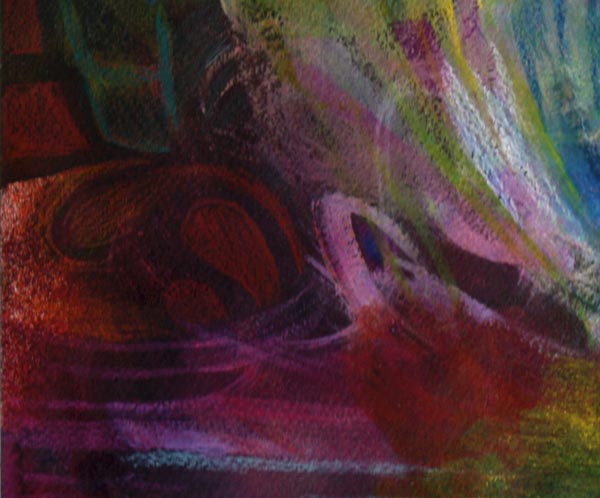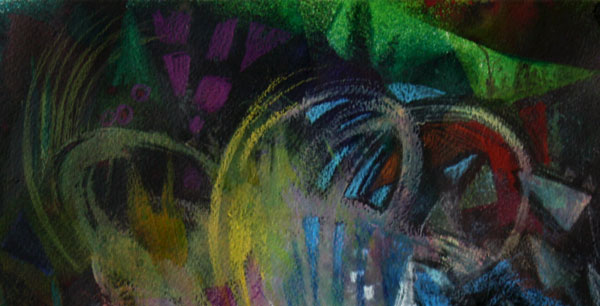Why Paint Intuitively?
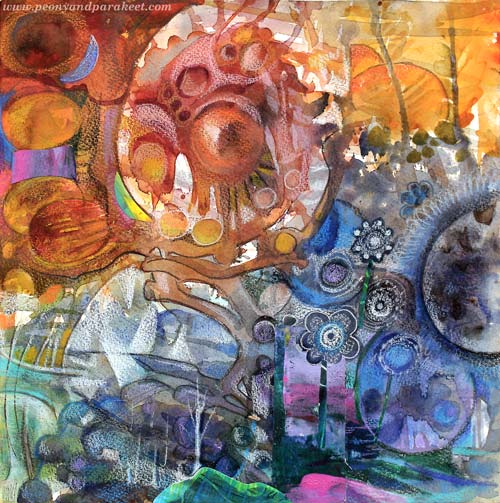
I have created this artwork using my intuitive painting methods. I had a busy week with many deadlines. Now, on Friday, when I stared at the blank watercolor paper, I felt that working in fast pace had disconnected me from my feelings. But then, this has happened many times before, so I just followed my tricks to get the painting on its way.
In most cases and especially when life gets busy, I choose to work intuitively, meaning that I do not plan the end result. My idea of fully experiencing art is to plan the process, but not sketch or otherwise pre-imagine the end result. I recommend this approach to everyone – at least once in a while. Why?
1) For once, you will let your creativity decide.
For many, this is rare: setting rationality aside. While living a busy life and organizing everyday chores, it is not so easy to suddenly start performing creatively. If your creativity never gets to decide, it might not have anything to say anymore.

When you paint intuitively, you can do against all those dont’s and won’ts that you keep hearing when your rationality is speaking. I find this kind of disobedience and freedom refreshing. It also brings balance to life.
2) You will use colors more creatively.
I often hear people saying that they need to learn more about colors. I used to wonder what it would be – color theories? In the end, there’s not so much to learn to get some results, even if you studied the master of colors Josef Albers and his color theory. But after working with colors and teaching the use colors, I get it: many people use too little variation in color. Color areas look more alive when they are not even. They can also contain controversial and muddy tones; it just makes the bright tones pop.
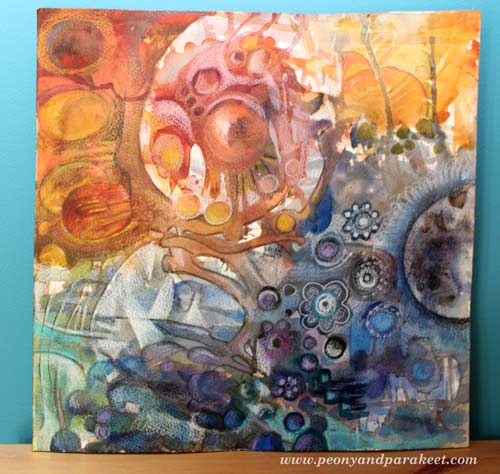
When you start painting intuitively and do not aim for a certain result, you will more likely get colors mixed together. At the certain point, like me when making this artwork, you might want to decide what your painting represents of. But then your grass will not be green, and your sky will not be blue. (Actually, here it’s vice versa!) Furthermore, there will be much more to look at than big even color areas or evenly spread, individual, same-sized elements that our rational side is so fond of.
3) You will find a fast route to your own style.
After you have practiced working intuitively, you will begin to see similarities in your work. You will get to know the little things your creative side loves. From those, you can start building your own style! Many people think that if they gather images that they are especially fond of, that will make them find their style. But 100 Pinterest boards is nothing compared to practicing intuitive painting. Why?
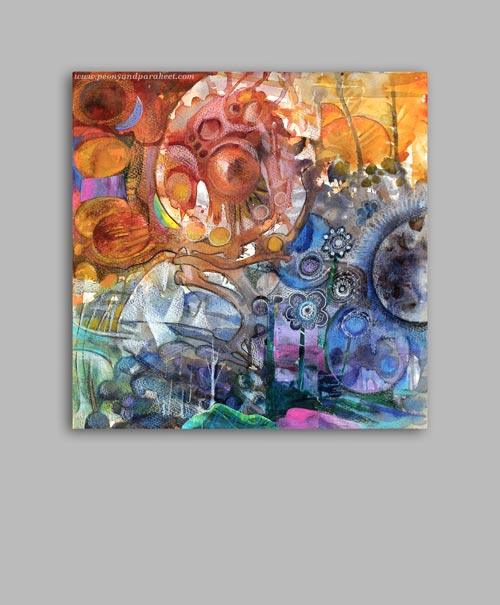
Because your style is not defined by the things that you love at the moment. First, our desires are often affected by trends and general aesthetics, among other things. Second, we easily admire things that might have some resemblance to our style but tend to take it too literally. For example, I admire very simple graphic patterns. Still, my style is far from that. Someday, it might develop to that. But at the moment, the essence of my art is somewhere else. It might be my love for textiles that trigger the appeal for those graphic shapes.
Paint intuitively, paint naturally!
In the perspective of intuitive (meaning natural), it would be totally wrong to rationally copy the images and then be disappointed not being that good. When you paint starting from your inner world, you will find your own unique ways to self-expression. You will also be able to develop your style in line with the continuous changes that happen in your life.
The intuitive approach also makes painting fun and exciting. In the end, that’s what using creativity is essentially about!
Experiment by using a step-by-step process!
>> Buy Watercolor 101 for Intuitive Painting
Let Unconventional Inspire You

You know I love beautiful and decorative things. But the more I create, the more I feel that creating art should be expression first, aesthetics second. This watercolor collage is called “Leftright Wrongright” and it is about how sometimes the old wrong and unconventional can be the new right.
Rubber Stamp Art
If you think of experimental and avant-garde, would you ever consider using rubber stamps? In that context, they are the most boring thing. They are the absolutely wrong choice when you want to create unique and advanced art. But as my mission was to express how wrong can be right, I just could not resist taking the risk and using them! I painted the background with watercolors and then started stamping.
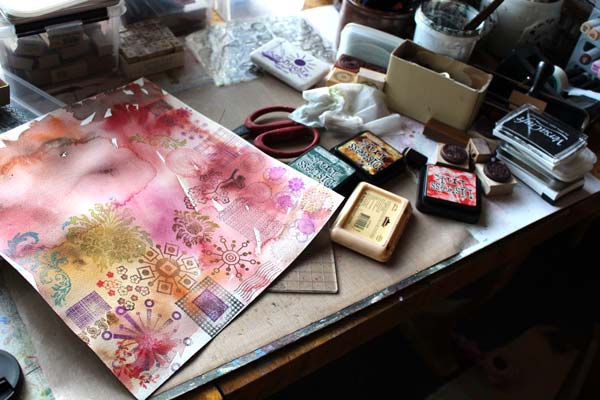
I only stamped once with each of the stamps. That way they were seen as individuals, not as a bunch of clones. I have used this principal before too, see Can Rubber Stamping be Art and Make Samplers to Save Bits and Pieces.
Watercolors
Watercolors are my trusted friend. They make the best backgrounds but also, they make rubber stamps look much more interesting. After the whole background was covered with stamped images, all different from each other, I added water and brushed the water-based ink to blend with watercolors.

With the big brush, I doodled this and that thinking fierce fully about destruction and bravery.
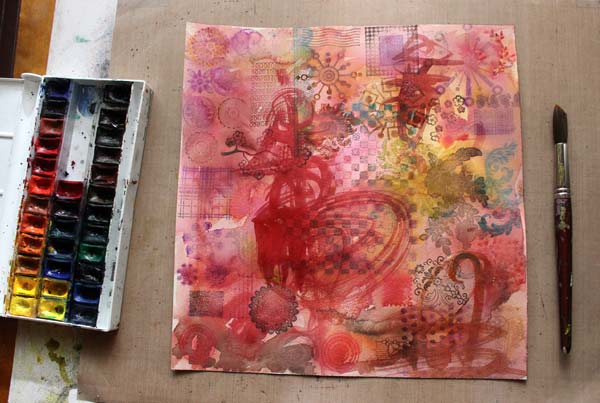
With a smaller brush, I added details and enhanced them with colored pencils.
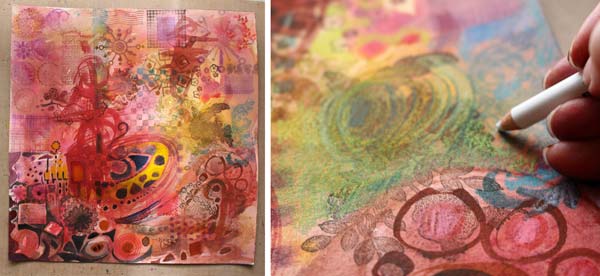
Imitating Rubber Stamps
To make the stamped images even more individual, I added hand drawing to make few of them bigger and more handmade. A thin drawing pen is great for imitating rubber stamps that have delicate details.
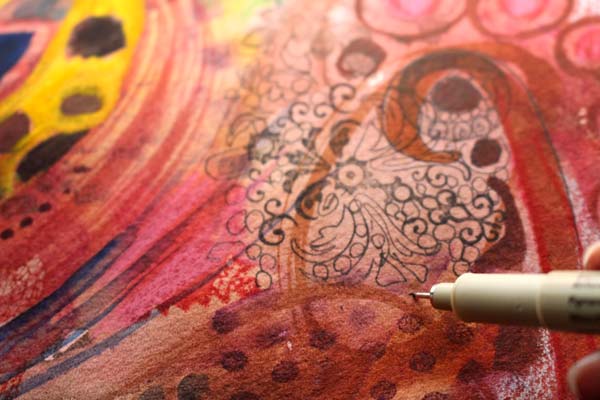
Finishing
When I worked with this artwork, it became clear to me that the final touches are crucial here. I should not only do what I usually do but add something that is against the rules, disrespectful even. First, I doodled with a white gel pen and let the doodling look a bit dreadful. Then, I grabbed a piece of paper, painted red and yellow with heavy acrylic paint. The unsophisticated color and the clumsiness of the shapes when I cut it made it look so wrong.
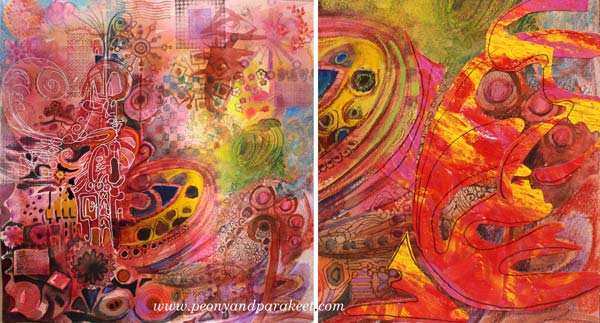
But I finished this artwork with a new attitude. As I wanted to express that sometimes we need to do things that make us feel uncomfortable, I needed to break my ordinary rules. I added few rough elements without over-decorating them. They are the wrong that makes the right spin. They make me ask: do right and wrong exist at all when creating art? If we think that unconventional is wrong, are we denying the true power of art and where it can take us?

Hopefully, this inspires you to add something wrong to your art, and make it right!
Let me be your art teacher: Subscribe to my weekly emails!
Embrace Chaos while Creating Art
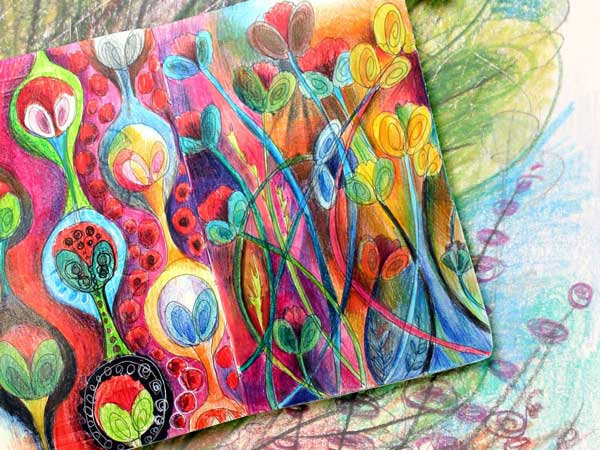
The first video blog post of the new year! This time the video a bit longer than usual as the subject is so close to my heart! The subject is the chaos and how you can use it while creating art. Hopefully you will enjoy the video!
Fast Start for Creative Painting
If you also like to paint, purchase my video: Watercolor 101 for Intuitive Painting. With the video you will learn the method where you don’t have to question your ideas before you start. You can just start and find the ideas along the process! Read more here!
Move Towards the Flow State!
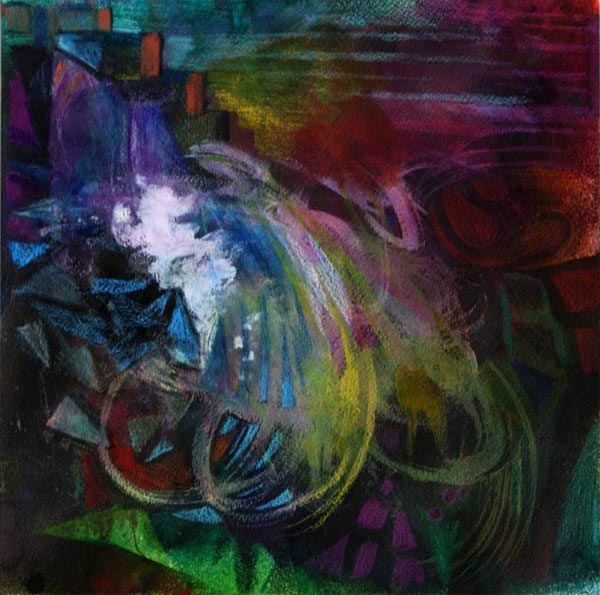
This mixed media painting is called Waterfall. It is inspired by the light in dark spaces.
Last week, I visited two places with old glass windows. The first was National Museum of Finland in Helsinki. The second was the Finnish painter Pekka Halonen’s summer cottage “Halosenniemi” in Tuusula. Both of them were built at the beginning of 20th century. Despite their windows, there’s fairly dark inside. While walking there, I saw how dark colors can be seen as soft and how daylight can look sharp.
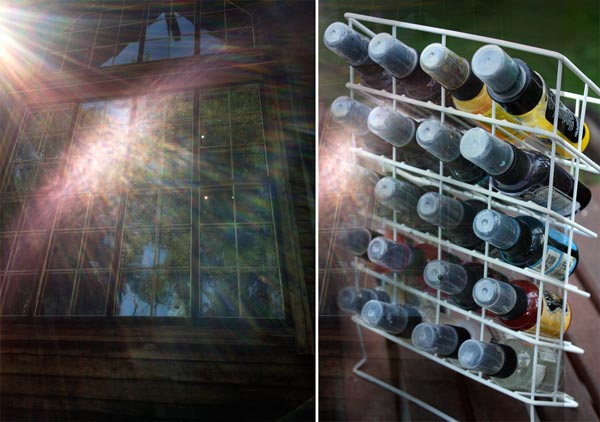
Perhaps the especially hot summer weather had it’s role too. No wonder I thought so positively about shadows and … water! I was tempted to use color sprays for this artwork. That way I could work outside and move around while creating.
A Big Mess with Acrylic Paints
Before spraying, I used acrylic paints to create color areas. They would work as a resist so that I could reveal them again after spraying. But the most important thing with the acrylics was: I grabbed a wide brush and said goodbye to rational thinking.
When you start with big brushes and create intersecting layers, you will naturally get into the creative mood. You will also begin to move. It’s often necessary to even stand up to make those big strokes wide enough. Check the front page of Heikki Marila’s website. He is a Finnish painter who creates huge paintings inspired by art history. See how those paintings are created, lots of movement there!
Also remember to change and mix colors as often as possible! Think that you are climbing towards the flow state where the creativity meets the happiness! Each interruption, the change in the movement and color, is one step closer to the flow.

The mess that I created with acrylics made my rational side cry and emotional side warm up. I was ready to get some fresh air and start even the bigger mess with sprays.
Entering the Flow State using Spray Mists and Handcut Stencils
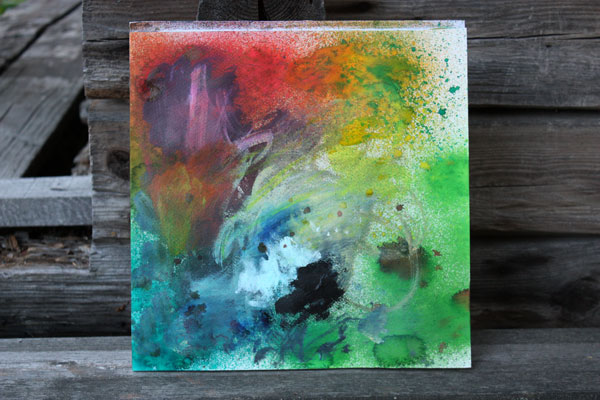
Here’s the first sprayed layer. Moving around the lawn and shaking the spray bottles were like a jump towards the flow state. I shook away the last rational thoughts and entered the happy state. I was flying.
Now, this is important: Be prepared to work quickly! When you get creative, you will get faster. There should be no need to rationalize what to do next or where to get the materials. They all have to be there. I had taken the scissors and a piece of paper with me. That allowed me to create stencils while waiting the layers to dry. I had also set up the blow dryer near the back door.
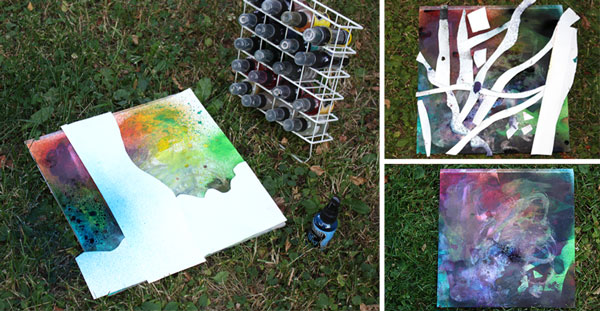
Running around the back garden with spray bottles, then inside to dry layers, then back again, I sprayed about five layers in total. As a result, I got the ugly mess shown in the photo right below. But I was not worried. I thought it looked amazing! One good thing when moving towards the flow: the inner critic leaves far behind!
I ended the day with spraying some areas with water. When wiping some of the spray ink away the acrylic paint areas were revealed.
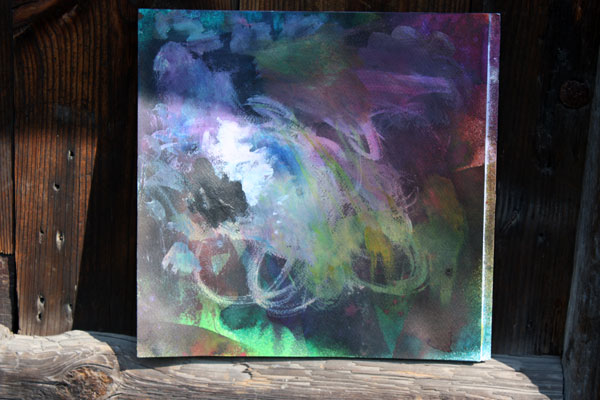
Next morning I had a problem to solve. How to finish the painting? I decided to create small geometric shapes with colored pencils to resemble the sharpness that light makes in the dark space.
Finishing with Colored Pencils
When using big brushes and big movements, creating details with small strokes adds interest and balance.

Colored pencils are wonderful to highlight the best and reshape the worst areas. When working with small details, I try to focus on one small area at the time.
In the “big” phase, my focus was in the big picture. Now, when working small, my focus is in the details.
Balanced Composition
When I had gone through all the areas, I began to look at the big picture again. Then I made the final tweaks. So here it is:
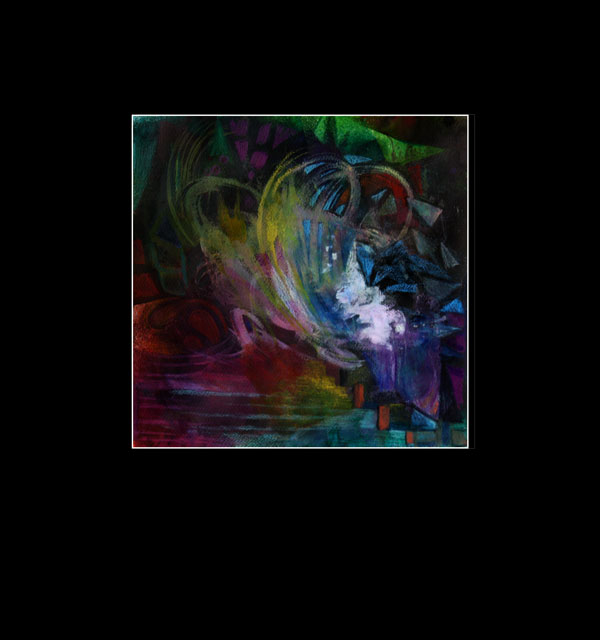
Hmm … wait a minute! Now it is upside down! Well, while coloring the work, I thought the direction would be this. But then, I noticed that it could be any of these three:
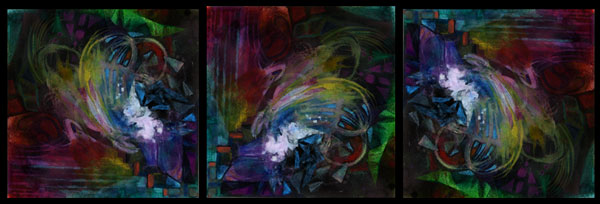
If the composition is balanced, the work will look balanced in any directions. By changing the direction, you can test if your composition is successful. Still, I rarely come to the result where changing the direction not only works but also tells the same story. I think that moving around the lawn had an impact here!
Experiment this in your art: Try to include physical movement into your creative process!
Subscribe to my weekly emails – Get a free mini-course!
